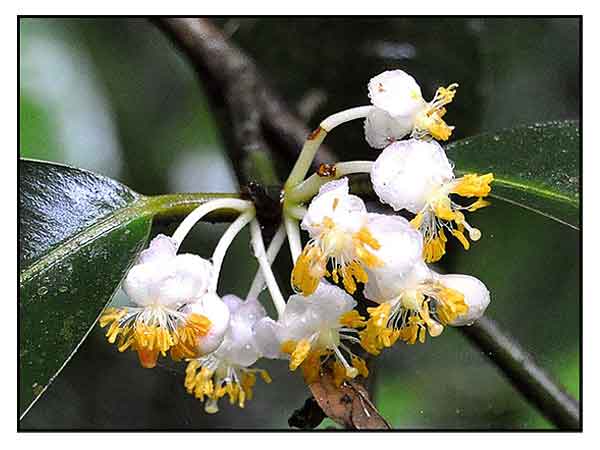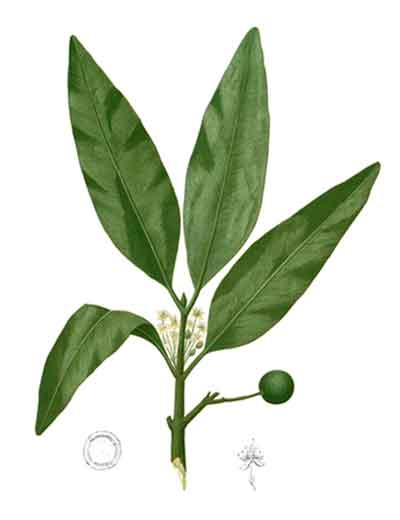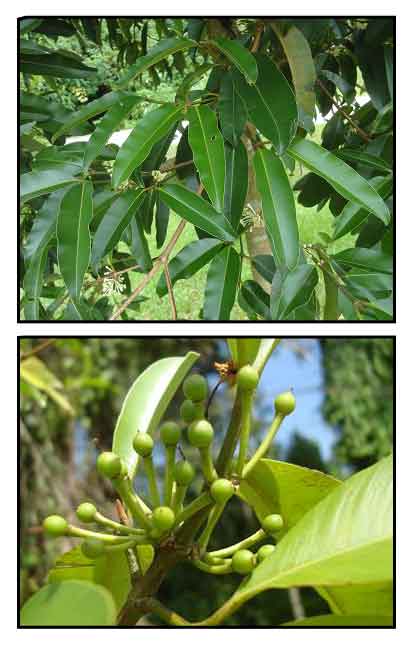 Gen info Gen info
- Calophyllum soulattri is a species of flowering plant in the Calophyllaceae family. It is considered one of the best bintangor timber species.
- Species epithet "soulattri" derives from Latin
for the local Sudanese name "Sulatri".
Botany
Calophyllum soulattri is a tree. Twigs fine tomentulose. Leaves oblong or narrowly ovate, 10-20 cm long, 3-7 cm wide, apically short acuminate into a drip tip, basally obtuse, the costa elevated or plane above, elevated beneath to the tip, sparingly puberulent, lateral veins evident, ribs (veins plus ducts) 39-40 per cm, the margins mostly not drying revolute, petioles 1-1.5 cm long, drying dark, minutely tomentose, grooved above. Inflorescences short cymes fasciculate in the leaf axils, crowded, the peduncle basally pubescent, bracts wanting, bracteoles obsolete; pedicels ca. 1.5 cm long, glabrous, slender. Flowers perfect, sepals 2; petals 2(-3), ca. 8 mm long, rotund, apically ciliolate; stamens 60-100 (Stevens, 1976), the filaments ca. 3 mm long, basally connate, the anthers oblong, ca. 2 mm long; ovary glabrous, the style ca. 3 mm long, the stigma peltate. Fruit ovoid to globose, ca. 10 mm across, sometimes apiculate, drying brown, often glaucous, more or less smooth. This species is recognizable by the very numerous ribs of the leaves and by the small fruit. (Flora de Panama)
 Calophyllum soulattri is a tree, 4.5 m to 26 m tall. Trunk is rarely buttressed, spurred, occasionally with kneed roots when grown in swampy conditions. Outer bark is yellowish to pale brown in color, with shallow, boat-shaped fissures. Leaves are stalked, opposite, ovate to elliptic or suboblong, 6.5-29 cm long by 2.4-10.2 cm wide, with prominent parallel secondary veins. New leaves are pinkish in color, turning orange, then beige before maturing to green. Flowers are white and fragrant. Fruits are spherical, purplish black, 9-16 mm long. (Flora & Fauna Web) Calophyllum soulattri is a tree, 4.5 m to 26 m tall. Trunk is rarely buttressed, spurred, occasionally with kneed roots when grown in swampy conditions. Outer bark is yellowish to pale brown in color, with shallow, boat-shaped fissures. Leaves are stalked, opposite, ovate to elliptic or suboblong, 6.5-29 cm long by 2.4-10.2 cm wide, with prominent parallel secondary veins. New leaves are pinkish in color, turning orange, then beige before maturing to green. Flowers are white and fragrant. Fruits are spherical, purplish black, 9-16 mm long. (Flora & Fauna Web)
Distribution
- Native to the Philippines.
- Grows in lowland or lower montane rain forest; sometimes in swamp forest, up to 1700m altitude.
- Planted as shade tree or ornamental.
- Also native to Andaman Is., Bismarck Archipelago, Borneo, Cambodia, Caroline Is., Jawa, Lesser Sunda Is., Malaya, Maluku, New Guinea, Nicobar Is., Northern Territory, Solomon Is., Sumatera, Thailand, Vietnam.
(1)
Constituents
- Study of stem bark isolated one new pyranoxanthone, soulattrin (1), together with three other xanthones, caloxanthone B (2), caloxanthone C (3), macluraxanthone (4), the triterpene friedelin (5), and the steroid stigmasterol (6). (2)
- Study of stem bark isolated a new pyranocoumarin, soulamarin (1), together with five xanthones calooxanthone B (2), caloxanthone C (3), macluraxanthone (4), trapezifolixanthone (5) and brasixanthone B (6), one common triterpene, friedelin (7), and the steroidal triterpene stigmasterol (8).
(3)
- Study of stem bark of Calophyllum soulattri afforded soulattrin (3), phylattrin (4), caloxanthone C (9), brasixanthone B (10) and trapezifolixanthone (11).
(see study below) (4)
- LC-MS/MS analysis of methanol extract and fractions of C. soulattri yielded polyporusterone A, poricoic acid D, polyporusterone F, exculentagenin, and 1-acetyl-3-(methoxy-carbonyl)-ß-carboline. (see study below)
(6)
- Study of hexane and dichloromethane extracts of stem bark of C. soulattri yielded two new prenylated xanthones, soulattrin (1) and phylattrin (2), along with four other xanthones, macluraxanthone (3), caloxanthone C (4), brasixanthone B (5), and trapezifolixanthone (6). (see study below) (7)
- Study of stem bark of C. soulattri isolated a new phloroglucinol, calosubellinone (1), along with two known compounds, garsubellin B (2) and soulattrone A (3). (see study below) (9)
- Study of methanol extract of stem bark isolated two secondary metabolites steroids: stigmasterol and stigmasterone.
(12)
- Study of stem bark isolated two new isoprenylated benzofuran 3-ones, airlanggin A (1) and B (2) along with two known xanthones, ananixanthone (3) and trapezifolixanthone (4). (see study below) (13)
- Study of stem bark for secondary metabolites isolated a new diprenylated xanthone, phylattrin (1), along with five xanthones, soulattrin (2), caloxanthone C (3), macluraxanthone (4), and trapezifoli- xanthone (6), and two common sterols, stigmasterol (7) and ß-sitosterol (8). (see study below)
(14)
 Properties Properties
- Studies have suggested antibacterial, antiproliferative, anticancer, non-teratogenic properties.
Parts used
Leaves, root, stem bark, leaves, seed oil.
Uses
Edibility
- Fruit is edible, but sour. There is advice not to eat it in large quantities because it can cause stomach pains and diarrhea.
Folkloric
- In Indonesia, infusion of root applied externally for rheumatic pains.
- Seed oil applied externally for rheumatism, wounds, and skin problems.
- Used for treatment of inflamed eyes and gout.
- Fresh bark from shoots used by women who have just given birth. Refined oil injected into the muscles to relieve pain in leprosy. (8)
Others
- Seed oil: Seed oil used as illuminant and for soap making.
- Poison: Latex used as dog poison.
- Wood: Wood is light-red, moderately hard, durable. Used for house construction, planks, masts, spars.
- Veterinary: Used as tonic for horses.
- Fuel: Bark has charcoal potential. (see study below) (16)
Studies
• Antiproliferative Xanthones / Stem Bark: Study of stem bark of Calophyllum inophyllum and C. soulattri isolated 11 xanthones. Calophyllum soulattri afforded soulattrin (3), phylattrin (4), caloxanthone C (9), brasixanthone B (10) and trapezifolixanthone (11). Cytotoxicity screening by MTT assay on all the xanthones using five human cancer cell lines indicated good activities for some of these xanthones. (4)
• Antibacterial / Leaves, Root and Stem Bark: Study evaluated methanol extracts of leaves, root, and stem barks of C. soulattri partitioned with petrol, dichloromethane, and ethyl acetate for antimicrobial activity using disc diffusion method. The extracts demonstrated a range of antibacterial activity, which improved on fractionation. There was not activity against moulds. (5)
• Cytotoxicity / MCF-7 Breast Cancer Cell Line /
Stem Bark: Study evaluated stem bark extract and fractions of C. soulattri for toxicity against MCF-7 breast cancer cells. The methanol extract and n-hexane fraction showed strong cytotoxic activity with IC50s of 93.6 and 36 µg/mL, respectively. Results showed potential activity as an anticancer agent that can inhibit MCF-7 breast cancer cell growth. (see constituents above) (6)
• Cytotoxicity Against Human Cancer Cell Lines / Stem Bark: Study of hexane and dichloromethane extracts of stem bark of C. soulattri yielded two new prenylated xanthones, soulattrin (1) and phylattrin (2), along with four other xanthones, macluraxanthone (3), caloxanthone C (4), brasixanthone B (5), and trapezifolixanthone (6). Compounds 1-6 were evaluated for cytotoxicity towards nine human cancer cell lines: SNU-1 (stomach), HeLa (cervix), Hep G2 (liver), NCI-H23 (lung), K562 (leukemia), Raji (lymphoma), LS174T (colon), IMR-32 (neuroblastoma) and SK-MEL-28 (skin) cells in vitro using the MTT method. All the xanthones exhibited significant cytotoxic activity with low IC50s ranging from 0.27 to 9.89 µg/mL. (7)
• Anticancer / Antiproliferative / Stem Bark: Study of stem bark of C. soulattri isolated a new phloroglucinol, calosubellinone (1), along with two known compounds, garsubellin B (2) and soulattrone A (3). Compounds 1 and 2 showed growth inhibitory activities against HeLa cancer cells comparable to positive control cisplatin, with IC50s of 19.3 and 16.5 µM, respectively. Compound 2 also showed antiproliferative activity against MDA-MB-231 cancer cell line with IC50 of 17.7 µM. (9)
• Antihypertriglyceridemia / Toxicity / Leaves: Study evaluated the in vivo effect of oral administration of binntagur leaves ethanolic extract on transaminase, lipid profile, and histological changes in experimental rats. The ethanolic extract increased transaminase profile, ALT and AST, with the highest increase with the 400 mg/kbw dose. Histologically, there was necrosis of hepatocytes cells in 1000 mg/kbw dose and congestion of central vein with 400 and 1000 mg/kbw doses. Heart muscle fibers showed irregular structure in 1000 mg/kbw in female rats. Results suggest increase transaminase profile and some damaging effect on liver and heart of Wistar rat. In lipid profile, the EE did not affect total cholesterol level, but caused significant decrease (p<0.05) in triglyceride profile with 1000 mg/kbw. (10)
• No Teratogenic Effects / Leaves: Study of evaluated the tetratogenic effect of bintangur leaves ethanol extract to Sprague Dawley strain white rats using doses of 100 and 500 mg/kbw. Cesarean section was performed on pregnant rat at the 20th day and observed for body weight, fetal biometrics, morphological malformation and skeletal formation. Results showed no teratogenic effect. (11)
• Airlanggins and Xanthones / Cytotoxicity Against P-388 Cells / Stem Bark: Study of stem bark isolated two new isoprenylated benzofuran 3-ones, airlanggin A (1) and B (2) along with two known xanthones, ananixanthone (3) and trapezifolixanthone (4). Tested for cytotoxicity against P-388 cells, compound 3 showed most activity with IC50 0.68 µg/mL and compound 1 showed moderate activity with IC50 5.80 µg/mL. (13)
• Phylattrin / Cytotoxic Xanthone / Stem Bark: Study of stem bark for secondary metabolites isolated a new diprenylated xanthone, phylattrin (1), along with five xanthones, soulattrin (2), caloxanthone C (3), macluraxanthone (4), and trapezifolixanthone (6), and two common sterols, stigmasterol (7) and
ß-sitosterol (8). Compounds 1-7 showed moderate cytotoxic activities against SNU-1, HeLa, HepG2, NCI-H23, K562, Raji, LS174T, IMR-32, and SK-MEL-28 cells. (14)
• No Cytotoxicity on T47D Breast Cancer Cell Line / Leaves: Study evaluated the cytotoxic effect of ethanol extract and fraction of C. soulattri leaf toward T47D breast cancer cell line by MTT method. Results showed ethanol leaf extract and fraction did not have cytotoxic effect on T47D breast cancer cell line. (15)
• Fuel Properties of Charcoal Briquettes from Coconut Husk and Bitanghol Bark: Study evaluated the fuel properties of briquettes made from coconut (Cocos nucifera) husk, Bitanghol-sibat (C. soulattri) bark and combination of the two materials at ratios of 90%husk:10%bark, 80%:20%, and 70%:30%, analyzing moisture content, volatile matter, ash content, fixed carbon, gross calorific value and elemental composition. Results showed pure bitanghol sibat bark briquette has better fuel properties than coco husk. Enhanced fuel properties were observed with the combination of husk and bark briquettes, most improved with the 70:30 combination, which showed lower sulfur content and minimal polluting effect. (16)
Availability
Wild-crafted. |

![]()




 Calophyllum soulattri
Calophyllum soulattri
